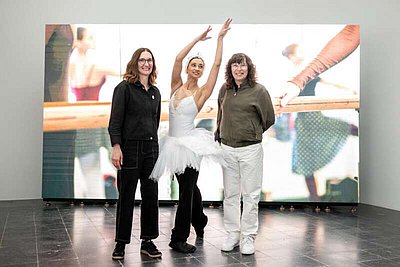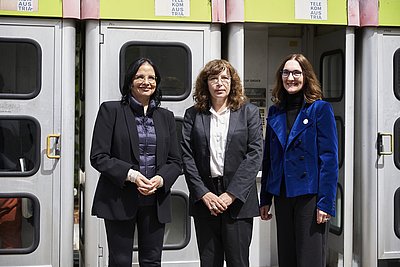Welcome at the Interface Culture program website.
Acting as creative artists and researchers, students learn how to advance the state of the art of current interface technologies and applications. Through interdisciplinary research and team work, they also develop new aspects of interface design including its cultural and social applications. The themes elaborated under the Master's programme in relation to interactive technologies include Interactive Environments, Interactive Art, Ubiquitous Computing, game design, VR and MR environments, Sound Art, Media Art, Web-Art, Software Art, HCI research and interaction design.

The Interface Culture program at the Linz University of Arts Department of Media was founded in 2004 by Christa Sommerer and Laurent Mignonneau. The program teaches students of human-machine interaction to develop innovative interfaces that harness new interface technologies at the confluence of art, research, application and design, and to investigate the cultural and social possibilities of implementing them.
The term "interface" is omnipresent nowadays. Basically, it describes an intersection or linkage between different computer systems that makes use of hardware components and software programs to enable the exchange and transmission of digital information via communications protocols.
However, an interface also describes the hook-up between human and machine, whereby the human qua user undertakes interaction as a means of operating and influencing the software and hardware components of a digital system. An interface thus enables human beings to communicate with digital technologies as well as to generate, receive and exchange data. Examples of interfaces in very widespread use are the mouse-keyboard interface and graphical user interfaces (i.e. desktop metaphors). In recent years, though, we have witnessed rapid developments in the direction of more intuitive and more seamless interface designs; the fields of research that have emerged include ubiquitous computing, intelligent environments, tangible user interfaces, auditory interfaces, VR-based and MR-based interaction, multi-modal interaction (camera-based interaction, voice-driven interaction, gesture-based interaction), robotic interfaces, natural interfaces and artistic and metaphoric interfaces.
Artists in the field of interactive art have been conducting research on human-machine interaction for a number of years now. By means of artistic, intuitive, conceptual, social and critical forms of interaction design, they have shown how digital processes can become essential elements of the artistic process.
Ars Electronica and in particular the Prix Ars Electronica's Interactive Art category launched in 1991 has had a powerful impact on this dialog and played an active role in promoting ongoing development in this field of research.
The Interface Cultures program is based upon this know-how. It is an artistic-scientific course of study to give budding media artists and media theoreticians solid training in creative and innovative interface design. Artistic design in these areas includes interactive art, netart, software art, robotic art, soundart, noiseart, games & storytelling and mobile art, as well as new hybrid fields like genetic art, bioart, spaceart and nanoart.
It is precisely this combination of technical know-how, interdisciplinary research and a creative artistic-scientific approach to a task that makes it possible to develop new, creative interfaces that engender progressive and innovative artistic-creative applications for media art, media design, media research and communication.
Eröffnet: 60. Biennale di Venezia
20. April bis 24. November 204 Venedig, Italien
60. Internationale Kunstausstellung
Der österreichische Pavillon wurde am 18. April 2024 um 15.00 Uhr eröffnet.
Anna Jermolaewa gestaltet den österreichischen Pavillon auf der Biennale Arte 2024 in Venedig.
Kuratorin ist Gabriele Spindler.
Anna Jermolaewas Beitrag für den Österreich-Pavillon fügt sich hervorragend in das von Kurator Adriano Pedrosa formulierte Generalthema der Kunstbiennale 2024 ein, das mit Stranieri Ovunque – Foreigners Everywhere das Thema der Fremde, der Migration sowie Fragen nationaler Identität und kultureller Diversität in den Mittelpunkt stellt und Künstler*innen fokussiert, die Flucht und Migration aus eigener Erfahrung kennen.
In ihrer Arbeit erweist sich die in Leningrad (UdSSR) geborene und seit 1989 in Wien lebende Künstlerin immer wieder als genaue Beobachterin des menschlichen Zusammenlebens, seiner gesellschaftlichen Bedingungen und politischen Voraussetzungen. Für den österreichischen Beitrag spannt Jermolaewa einen Bogen von ihrer persönlichen Migrationserfahrung bis hin zu Formen des gewaltlosen Widerstands gegen autoritäre Regime. Die Präsentation im Pavillon wird Videos, Installationen, Leuchtobjekte, Sound und performative Elemente in einer Kombination aus neu entwickelten Arbeiten sowie Erweiterungen bereits bestehender Werke der Künstlerin umfassen.
Kunst- und Kulturstaatssekretärin Andrea Mayer: "Die Biennale Venedig ist die wohl weltweit bedeutendste Kunstausstellung und hat diesen Rang im vergangenen Jahr eindrucksvoll unter Beweis gestellt. Die Schau leistet nach wie vor einen ungemein wichtigen Beitrag zum ästhetischen, aber auch gesellschaftspolitischen, kulturellen wie auch interkulturellen Diskurs. Es ist gut und wichtig, dass Österreich auf der Biennale stark vertreten ist und einen entscheidenden Beitrag zu dieser internationalen Werkschau zeitgenössischer Kunst präsentiert. Gerade deswegen ist es mir eine große Freude, dass der österreichische Beitrag für 2024 besonders aktuelle und relevante Positionen einnehmen wird."

Kuratorin Gabriele Spindler (l.) und Künstlerin Anna Jermolaewa (r., im Bild mit Tänzerin Oksana Serheieva) beeindrucken mit ihrem Österreich-Beitrag zur Kunst-Biennale in Venedig. Foto: Land OÖ/Peter C. Mayr

Oksana Serheieva tanzt im Österreich-Pavillon; Foto © Markus Krottendorfer

"The Penultimate", Anna Jermolaewa, 2017, Installationsansicht, Biennale Arte 2024; Foto © Markus Krottendorfer

Eröffnung Österreich Pavillon, Biennale Arte 2024, v.l.n.r.: Andrea Mayer, Anna Jermolaewa und Gabriele Spindler; Foto © Studio Rio